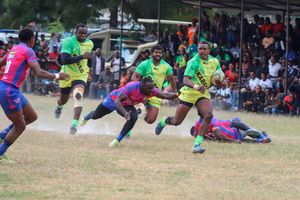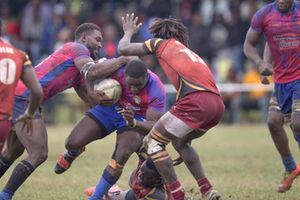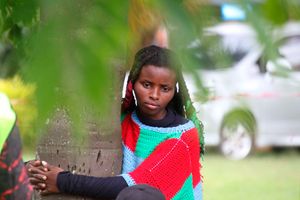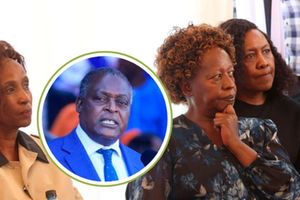
Simon David “Lofty” Reynolds (left) and Paul Okong'o at Pembroke House Preparatory School on July 7, 2016.
The 56th Kenya Cup winner will be decided today when defending champions Kabras Sugar face Menengai Oiler at the ASK Showgrounds in Kakamega.
Both teams are relative newcomers to the game with the now dominant Kabra going for their fifth title while Oilers are gunning for a historic first triumph. Kabras Sugar have contested 10 consecutive finals and are eyeing a fourth straight title.
They are well on course to matching extraordinary feats by teams that have excelled in this half century-old tournament that was started initially to spread the game in the country before growing to the biggest club tournament in the land.
According to the minutes of the Rugby Football Union of East Africa (RFUEA) for December13, 1968, a new competition, the Kenya Cup was proposed to be played alongside the Enterprise Cup, Eric Shirley Shield League and the Nairobi District & Championship (NDC) tournaments.
Consequently, the league was introduced in 1969 and named Kenya Lofty Cup in honour of Simon David “Lofty” Reynolds who was then Kenya and East Africa’s most capped player. He remains East Africa’s most capped player. It was “Lofty” Reynolds who in fact donated the Cup.
“The league was to be competed for by NDC contenders together with the upcountry teams of Nakuru, Mombasa and Kitale. The principle idea was to give upcountry teams more competitions,” recalled Reynolds in a 2016 interview
The very first Kenya Lofty Cup match was played at the Kitale Sports Club, Kitale, on March 8, 1969, between Kitale and Nondescripts Tigers. Other teams in the inaugural league were Impala, Kenya Harlequins, Nakuru and Mombasa.
The first final was played on August 16, 1969 and featured Nondescripts Tiger versus Impala, curtain raising the Enterprise Cup final contested by Kenya Harlequins and Kampala RFC.
Nondescripts defeated Impala by 17-14 to etch their name as the first Kenya Cup winners. Keith Mackenzie became the first captain to lift the trophy.
In 1970, the RFUEA dropped the name ‘Lofty’ and the league adapted the name it was been known to date, Kenya Cup.
Kampala RFC of Uganda entered the 1971 and 1972 competitions. The Ugandan side lost the 1972 final to a dominant Impala side that become the first side to win three titles in a row. Impala went on to win the league in 1973, 1974 and 1975. Winning the 1971, 1972 and 1973 leagues unbeaten underlined the Ngong Road-based side’s power then.
Kenya Army, coached by Fijian Illisoni Ligairi, became the first All-African side to take part in Kenya Cup, appearing in the 1971 competition and playing their home games at the Langata Barracks in Nairobi.
Dar-es-Salaam RFC and Arusha RFC kept the Tanzanian flag fluttering in the Kenya Cup winds between 1974 and 1977.
Kenya Harlequin Ruffians and Kenya Harlequin Vandals contested the 1976 final played on June 1 at RFUEA grounds, Nairobi. The match ended 9-9 draw with the two teams sharing the title.
Mean Machine RFC of the University of Nairobi won the Cup on 28 May 1977 beating Impala Boks 15-12 in the final.
Nondescripts won all the titles between 1978 and 1982, staying unbeaten in 1978 and 1979.
Mwamba RFC bolstered by displaced players from the two university teams Blak Blad (Kenyatta University) and Mean Machine, following the attempted military coup on August 1, 1982, won their only Kenya Cup in 1983. Barclays Bank clinched the 1987 edition.
Nondescripts returned to dominate the league, winning from 1991 to 1994 and registering a remarkable record of going 50 matches unbeaten.
Reynolds made an unprecedented 45 caps for the East Africa Tuskers between 1954 and 1969. He played in four Test matches against the heavyweights of world rugby then: versus British and Irish Lions on September 28, 1955; versus South African Springboks on February 25, 1961; versus British and Irish Lions on August 28, 1962; and versus 1964 Five Nations champions Wales on May 12, 1964. All matches were played at the RFUEA ground.
Reynolds played at lock and prop. He also distinguished himself at flank and number eight.
The talented Reynolds was born in Kampala on March 10, 1934 and learned to play rugby together with his older brother Peter at Pembroke Preparatory School in Gilgil, Kenya in the 1940s.
They both refined their rugby at Cheltenham College in England where they went for their Secondary School education. Reynolds was first capped by Uganda in 1954. He was first called up to replace Allan Irving Maclean in the inaugural Tuskers tour of the Copper Belt in Northern Rhodesia in 1954.
He was part of the East African team that played against the British and Irish Lions at the official opening of the Rugby Football Union of East Africa ground on September 28, 1955.
The tough forward missed only one representative game in 15 years following the death of his father. This was the East Africa game against the touring Barbarians in May 1958 at the RFUEA ground.
“My most memorable game was the East Africa vs South Africa Test. I started out at number 8 but was the one called upon to ‘pacify’ the Springbok props Johannes Myburgh and Stephanus Fannie Kuhn who broke the ribs of Tom Thorpe at the third scrum down. I was moved to prop as Tom left the pitch with three broken ribs,” said Reynolds.
“I was folded and ended up with my legs in the air at every scrum-down,” said Reynolds.in 2016. “I was strong like an ox and was never injured but that Springboks match was at another level.”
Reynolds won the Enterprise Cup with Nakuru in 1958, 1960, 1962 and 1963. He appeared in seven consecutive Enterprise Cup finals between 1958 and 1964 losing thrice and winning four times.
The 1958, 1960 and 1962 victories were special to him, on home soil at the Nakuru Athletics Club and as the team captain.
Long before a forward, New Zealand’s Zinzan Brooke dropped a goal in the 1995 World Cup semi-final against England at Newlands, South Africa; Lofty Reynolds had dropped a rare goal against a Combined Nchanga-Bancroft at Nchanga on the 1962 Tuskers tour of Northern Rhodesia.
“Lofty Reynolds was impossible as a back row, a true legend of the game. He was always in your face and never ever gave up continued,” stated his Tuskers colleague Mike Andrews.
Kevin Lilis remembers Reynolds as another farmer, the giant mainstay of Rift Valley rugby, a tough second row. Reynolds was also a good cricketer who played representative games at Lords.
He played an impeccable game for East Africa in their first ever home victory against Richmond in 1963 and for the Scorpions in a hard-fought win against touring Anti-Assassins in June 1965.
Reynolds lead Nakuru Athletics Club as president in 1971 and 1972.He was also a selector for the Rugby Football Union of East Africa.
At 38 years of age in 1972 he was still battling for honours in the Kenya Cup turning out for Kituru, the combined Kitale and Nakuru team that played in the league in 1971, 1972 and 1974.
Reynolds lives in New Zealand where he relocated in 1980. He is a frequent visitor to Kenya.
Okong’o is an East African rugby historian









